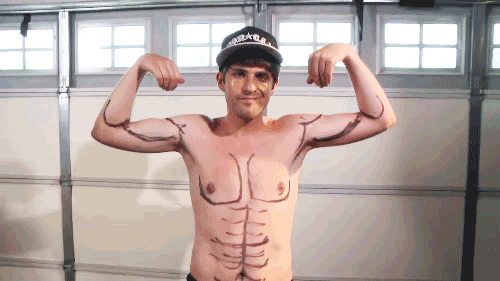How to Build Muscle for a Stronger, Leaner, Healthier You
Our content strives to support, inform, and motivate you to meet your health goals. We want to be your trusted source of expert- and science-backed info dispensed in simple, actionable ways. Read our Editorial Guidelines.
Whether it’s the bird house you built in school, that crazy tall Jenga tower, or that piece of IKEA furniture, it feels good to build things. Afterward, you can step back, admire the fruits of your labor, and go, “I did that. That was all me!”
And when you take time to build your muscles, you can multiply that sense of pride x10 — because this takes real work and dedication.
Plus, once you’ve got those muscles, you can use them for some pretty cool things. Play airplane with your kiddos, move that IKEA desk up four flights of stairs to your next apartment, or lift a bus off the ground with just your pinky finger (okay, maybe you won’t be able to do that last thing).
But, you don’t need more reasons why you should build muscle — you need to know how to build muscle.
We’ll explain the strength training program, diet, and support system you need to build muscle and create a stronger, healthier you.
How to Build Muscle

You’ve heard it before, you’re bound to hear it again, and you’re probably rolling your eyes and thinking, “yeah, I KNOW,” right now, but the way to build lean muscle — much like the way to decrease body fat, lose weight, or meet pretty much any health goal — is diet and exercise.
When you want to make muscle gains, the most effective workout is strength training, and the most effective diet is high in protein. Here’s how to build muscle using these principles.
Which Workouts Build the Most Muscle

While aerobic exercises — which include cardio workouts like endurance training and high-intensity interval training — are important for your overall health, strength training (aka resistance training) will have the biggest impact on your muscle size.
The Centers for Disease Control and Prevention (CDC) recommends a minimum of two strength training workouts per week. And they count activities like yoga and intensive gardening as strength training.
So, if you thought you needed to lift weights like a bodybuilder to achieve muscle hypertrophy (that’s fancy talk for muscle growth), think again! You don’t have to do any weight training or even know what muscle hypertrophy means to become your own version of a strong (wo)man.
The best strength training workout is one that you enjoy and will stick to. But, in order to grow your muscle size, you do need to work those muscles to a point of fatigue, which means you can’t do one more repetition without breaking your form.
Here are some classic and alternative strength training workout routines, plus tips to make them challenging enough to keep those muscles growing.
Calisthenics: Built around bodyweight exercises like push-ups, pull-ups, squats, lunges, and crunches, calisthenics exercises don’t require any equipment and consist of familiar poses you probably learned in your high school gym class. To make the exercises more challenging, try a progressive calisthenics workout.
Yoga, pilates, or barre: Yoga, pilates, and barre fitness classes all focus on toning, stretching, and using good form. If these workouts aren’t pushing your muscles to the point of fatigue, you can add ankle and wrist weights or opt for the more challenging variations of poses.
The 5x5 workout: This barbell workout consists of only a small number of reps (five to be exact) of a small number of exercises (yep, there are five) — bench presses, barbell squats, overhead presses, barbell rows, and deadlifts. You’ll lift heavier weights each week to keep building muscle mass.
Rowing: Much like rowing on gym equipment, rowing in real life is a great way to increase your upper body strength. Activities like kayaking, stand-up paddle boarding, and crew rowing all help build strength. To make them more challenging, try paddling against the current.
Compound exercises: These bodyweight exercises target multiple major muscle groups in a single movement. They include squats, lunges, tricep dips, push-ups, and step-ups. You can do these exercises anywhere without any equipment. To make them more challenging, you can add hand weights.
Gardening: If you have a green thumb, gardening can be a great workout. When you can do so safely, carry items like heavy bags of mulch or five gallon trees for a strength challenge.
Dumbbell exercises: Dumbbells are affordable at-home strength training equipment you can use with your calisthenic or compound exercise routines. Or, you can do classic exercises like the dumbbell row or bicep curls. You don’t need heavy weights to make dumbbell exercises effective. Start small and increase the amount of weight as you get stronger.
Rock climbing: This full-body workout will help you build lean muscle and flexibility. It improves your grip strength, upper body strength, and lower body strength. Find a rock gym and a climbing buddy to make this workout part of your regular routine. Then, you can easily progress your training by climbing harder routes.
Try each of these exercises until you find one you like and can stick with. Keep in mind, you’ll also need to make it more challenging week after week to keep building muscle. Plus, you have to pair it with the right diet before you’ll see muscle gains.
What to Eat to Build Muscle

When you’re trying to build muscle, all the rules of healthy eating apply.
Eat a diet rich in whole foods, including:
Lean protein
Fruits
Vegetables
Whole grain carbohydrates
Avoid foods that are high in trans fats and refined carbs, like sugar and white flour.
By far, the most important element of your diet for building muscle is your protein intake.
Here’s the mini science lesson: Your body uses the protein you eat to build skeletal muscles in a process called muscle protein synthesis. Muscle protein synthesis happens all the time whether you work out or not.
When you work out, you cause tiny tears in your muscle fibers. Your body uses the protein you eat to repair those tears, rebuild your muscle cells, speed muscle recovery, and — if you eat enough protein — increase your muscle size.
If you don’t eat enough protein, your body won’t have enough to synthesize muscle growth. As a result, you could experience muscle loss (gulp!) even if you’re doing regular resistance training.
Long story short, it’s very important that you eat enough protein. So, here’s how to do it.
How to Calculate Your Ideal Protein Intake

According to the American College of Sports Medicine, 10-35% of your daily calorie intake should come from protein if you want to keep your current muscle mass.
If you’re not a calorie counter, you can calculate protein intake with your body weight. Anyone under age 50 should aim to eat 0.35 grams of protein per pound of body weight.
If you’re over age 50, your body needs a bigger assist to build muscle mass, so you’ll need to consume an even higher amount of protein to see results. Aim for 0.45 grams of protein per pound.
When you’re ready to build muscle, not simply maintain it, you need to increase your protein intake even more — eating 0.5-0.8 grams of protein per pound of bodyweight.
If you’re not at your ideal body weight, calculate your protein intake based on your goal weight, rather than your current weight. If you want to lose fat and gain muscle, calculate your grams of protein based on your lower target weight or as a percentage of your lower calorie diet. And if you want to bulk up, calculate your grams of protein based on your weight gain goal or as a percentage of your extra calorie intake.
In addition to eating enough protein, you’ll also need to make sure the protein you’re eating contains all nine of the essential amino acids.
Monitoring Your Amino Acid Intake

Animal-based proteins, like meat, fish, eggs, and dairy products, are considered complete proteins because they include all nine essential amino acids. Meat provides the highest protein bang for your buck. A three-ounce serving contains about 20 grams of protein.
If you’re on a plant-based diet, you’ll need to work harder to make sure that you not only get enough protein, but that you get all of your essential aminos. Consuming a combination of multiple high-protein plants everyday will give you the best results.
Here are good plant-based protein sources to add to your diet:
Quinoa
Brown rice and beans
Soy, tofu, and tempeh
Buckwheat
Nuts and seeds
Nutritional yeast
Whether you eat meat or not, aim to get most of your protein from whole foods. While post-workout protein shakes made from whey or plant-based protein powders are an easy “whey” ... ahem, way ... to add more protein to your diet, you shouldn’t rely on supplements like protein powder to provide more than 10% of your daily protein intake.
Protein powders are highly processed and often lack the fiber, minerals, and other micronutrients you can get from whole foods. Plus, some protein supplements are loaded with added sugars — so they’re simply a less healthy choice overall.
When to Get a Personal Trainer

Even the strongest people can’t do everything on their own. When you’re figuring out how to build muscle, a personal trainer can help you find the right nutrition and strength training program to meet your goals.
Here are a few of the other things a trainer can help you with:
Stay motivated: A trainer is an accountability partner who will check in regularly, help you fit workouts into your busy schedule, and cheer you on as you reach your goals.
Fine-tune your diet: Nutritionists and personal trainers can help you analyze your eating habits and make small sustainable changes that will increase your protein intake and decrease your intake of unhealthy, processed foods and trans fats.
Perfect your form: Every beginner should consult with a personal trainer before attempting to do weight training or bodyweight exercises for the first time. A trainer can teach you the proper form and help you prevent injuries.
Get past a plateau: It’s common to hit a plateau when you’re trying to build muscle. When that happens, you’ll need to change up your routine to make it more sustainable or challenging. A trainer can help you identify the cause of your plateau and create a fitness program that gets you past it and keeps you moving toward your goal.
How Long Does It Take to Build Muscle?
When it comes to building muscle, patience — much like diligence — is a virtue. If you follow your strength training program diligently, you can expect to start seeing results in 4-8 weeks.
We’re talking visible, physical results, like increased muscle mass and decreased body fat. You may notice intangible results, like higher energy levels, better mood, and improvements to your overall wellness, after only a few workouts.
Rome Wasn’t Built in a Day

And sadly, muscle tone can’t be built that quickly either. But, you can get started today.
Choose a strength training exercise program that appeals to you. From body weight exercises to weight lifting routines to hobbies that require mucho muscles (like rowing or climbing), any strength training program can help you get started. Pair that program with a diet that’s high in protein, and that’s how to build muscle.
It sounds easy, and it is easy to get started. But, along your journey, you might need more motivation, accountability, or advice on keeping your diet in check, perfecting your weight lifting form, getting past a plateau, or progressing your workouts.
Whenever you need a helping hand, our online personal trainers are here for you. They can provide strength training workouts, nutritional guidance, and ongoing motivation for as little as $3 a day. Talk to a trainer to see how they can help you meet your goals.